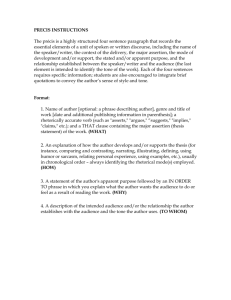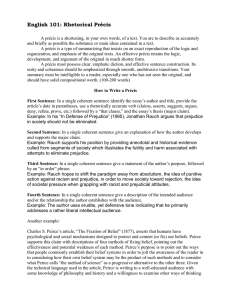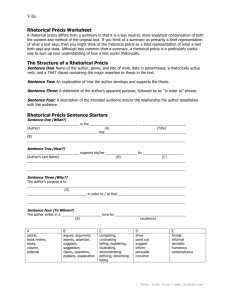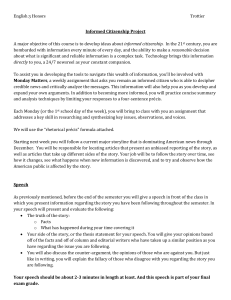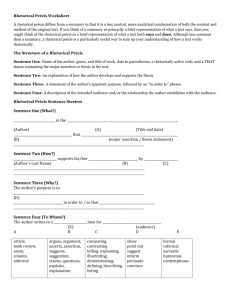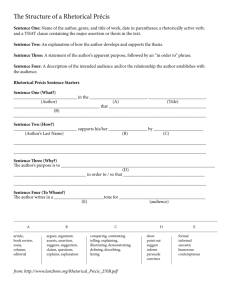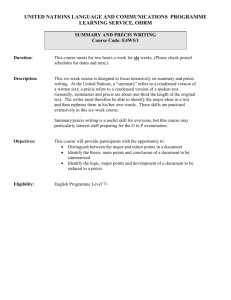Sample Rhetorical Précis
advertisement
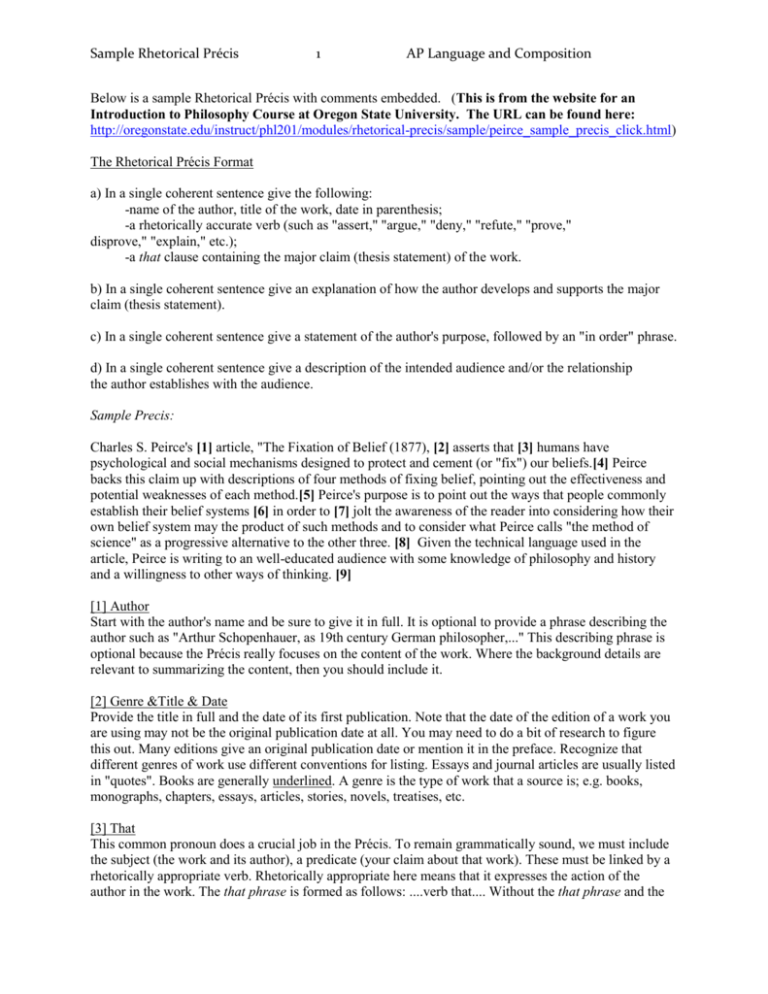
Sample Rhetorical Précis 1 AP Language and Composition Below is a sample Rhetorical Précis with comments embedded. (This is from the website for an Introduction to Philosophy Course at Oregon State University. The URL can be found here: http://oregonstate.edu/instruct/phl201/modules/rhetorical-precis/sample/peirce_sample_precis_click.html) The Rhetorical Précis Format a) In a single coherent sentence give the following: -name of the author, title of the work, date in parenthesis; -a rhetorically accurate verb (such as "assert," "argue," "deny," "refute," "prove," disprove," "explain," etc.); -a that clause containing the major claim (thesis statement) of the work. b) In a single coherent sentence give an explanation of how the author develops and supports the major claim (thesis statement). c) In a single coherent sentence give a statement of the author's purpose, followed by an "in order" phrase. d) In a single coherent sentence give a description of the intended audience and/or the relationship the author establishes with the audience. Sample Precis: Charles S. Peirce's [1] article, "The Fixation of Belief (1877), [2] asserts that [3] humans have psychological and social mechanisms designed to protect and cement (or "fix") our beliefs.[4] Peirce backs this claim up with descriptions of four methods of fixing belief, pointing out the effectiveness and potential weaknesses of each method.[5] Peirce's purpose is to point out the ways that people commonly establish their belief systems [6] in order to [7] jolt the awareness of the reader into considering how their own belief system may the product of such methods and to consider what Peirce calls "the method of science" as a progressive alternative to the other three. [8] Given the technical language used in the article, Peirce is writing to an well-educated audience with some knowledge of philosophy and history and a willingness to other ways of thinking. [9] [1] Author Start with the author's name and be sure to give it in full. It is optional to provide a phrase describing the author such as "Arthur Schopenhauer, as 19th century German philosopher,..." This describing phrase is optional because the Précis really focuses on the content of the work. Where the background details are relevant to summarizing the content, then you should include it. [2] Genre &Title & Date Provide the title in full and the date of its first publication. Note that the date of the edition of a work you are using may not be the original publication date at all. You may need to do a bit of research to figure this out. Many editions give an original publication date or mention it in the preface. Recognize that different genres of work use different conventions for listing. Essays and journal articles are usually listed in "quotes". Books are generally underlined. A genre is the type of work that a source is; e.g. books, monographs, chapters, essays, articles, stories, novels, treatises, etc. [3] That This common pronoun does a crucial job in the Précis. To remain grammatically sound, we must include the subject (the work and its author), a predicate (your claim about that work). These must be linked by a rhetorically appropriate verb. Rhetorically appropriate here means that it expresses the action of the author in the work. The that phrase is formed as follows: ....verb that.... Without the that phrase and the Sample Rhetorical Précis 2 AP Language and Composition associated subject and predicate, you cannot have a well-formed Précis. subject (the work and its author and date) verb that predicate (your claim about that work) "Plato, in Book I of his dialogue The Republic (360 BCE), demonstrates that justice is better than force." "Sissela Bok, in her book Lying (1979), argues that lies can be justified in some circumstances." "Imannuel Kant, in his essay The Doctrine of Virtue (1797), asserts that lying is morally wrong under any circumstances." [4] Thesis The thesis, or major claim, of the work is statement of the overall and final point that it aims at. It is not easy to identify the thesis of a philosophical work (or novel, for that matter). Still, it is a basic part of philosophical reading to be able to say briefly what the main claim of the work is. Note that this claim may never be stated by the author as such. You may have to interpret and synthesize to draw out a thesis. This work is essential because it is the base of your reading. The thesis statement you attribute to a work is your concise summary of what you understood the author's point to be. You may find it frustrating to put the meaning of a long, complex work into a single sentence. If you simply draw a blank or cannot get the words to come out right, that is a sign that you need to read the work again with the intention of getting the major claim. [5] Explanation The task of this sentence is to explain how the thesis, presented in the last sentence, is developed by the author. The author may give several arguments for a single thesis. Or the author may give a chain of arguments leading up to the thesis. The author may define key concepts related to the thesis. Your job in reading intellectual literature is to identify how the main claim is produced by the work. We take it as a basic standard here that sophisticated literature does not merely make claims, it provides support for them. [6] Purpose A statement of the author's purpose in writing this work. What is the writer trying to accomplish here? This statement of purpose is connected to the audience effect by the in order to phrase. Author's purpose in order to effect on the reader [7] In Order To This phrase is crucial to the Précis. It directly indicates the effect the author intends to have upon the audience. To produce this sentence, think about what change will occur in the reader if the author's purpose is successful. Authors may write with the purpose to persuade, to refute, to change, even to frighten, anger, or confuse. Determine what you think the author's purpose is and what that purpose is supposed to do to the reader. Note that the purpose may or may not be successful (i.e. it may not have the intended effect). Author's purpose in order to effect on the reader [8] Effect A statement of the author's intended effect on the reader. This statement of purpose is connected to the audience effect by the in order to phrase. Every author writes to have some effect on the audience (readers). It may be to make the audience laugh, to cause the audience to question their own beliefs, to persuade them to a point of view, to challenge a belief they are likely to have, etc. Sample Rhetorical Précis 3 AP Language and Composition This effect is not a report of how the work affects you, but of what you think the author's intended effect is. Author's purpose in order to effect on the reader [9]Audience A statement of the author's intended audience and the relationship the author establishes with the audience. The language of a work selects a certain audience and excludes others. Examine the language and references of the work to judge what sort of pre-knowledge the author assumes of the reader.
